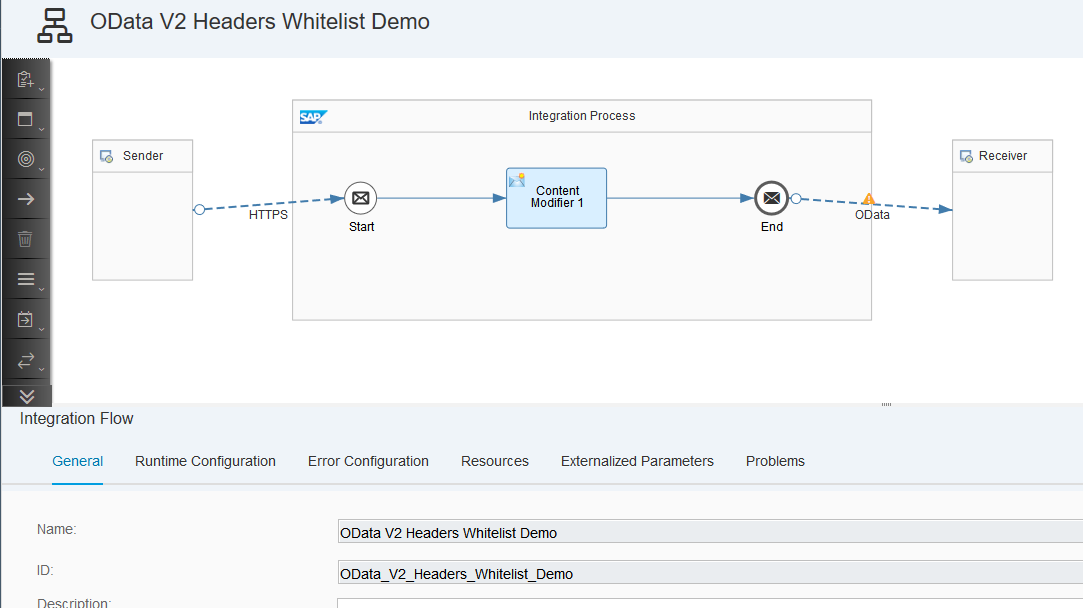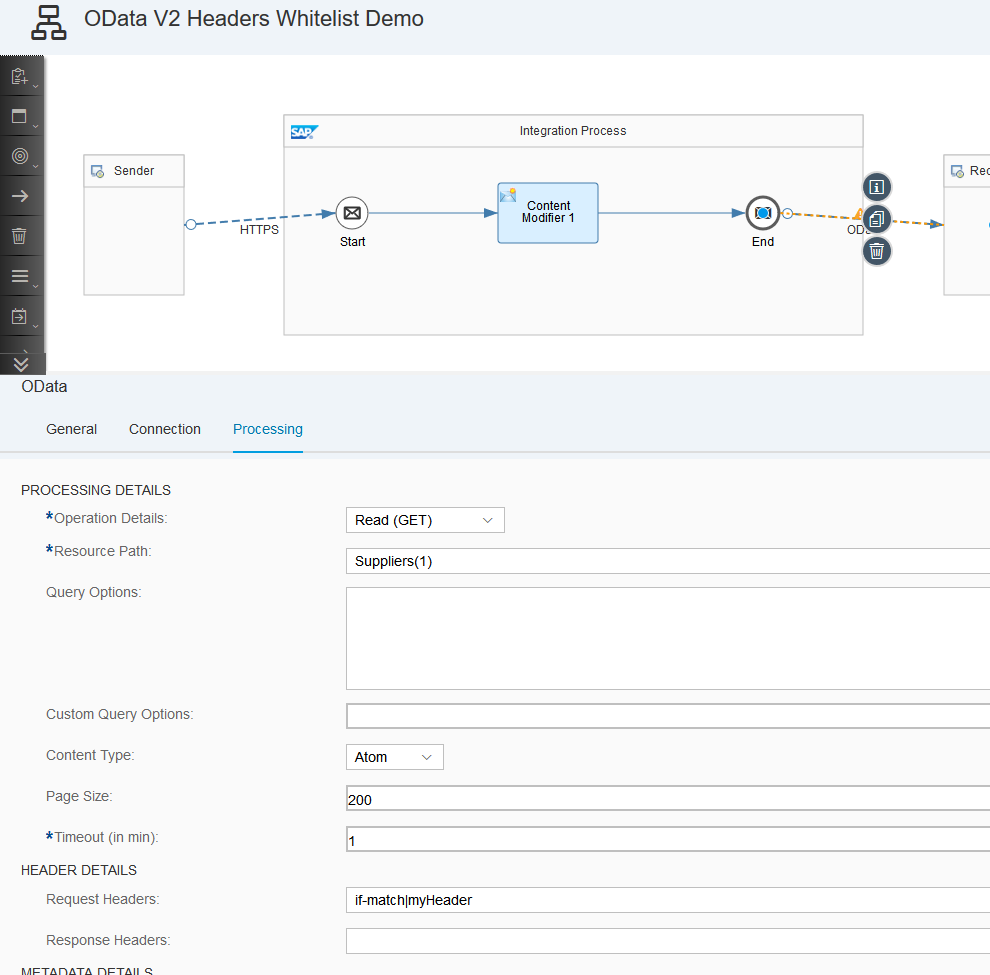
- SAP Community
- Products and Technology
- Technology
- Technology Blogs by SAP
- SAP Cloud Integration – Allowed Headers in OData V...
Technology Blogs by SAP
Learn how to extend and personalize SAP applications. Follow the SAP technology blog for insights into SAP BTP, ABAP, SAP Analytics Cloud, SAP HANA, and more.
Turn on suggestions
Auto-suggest helps you quickly narrow down your search results by suggesting possible matches as you type.
Showing results for
Associate
Options
- Subscribe to RSS Feed
- Mark as New
- Mark as Read
- Bookmark
- Subscribe
- Printer Friendly Page
- Report Inappropriate Content
01-16-2019
5:42 AM
Introduction
As described in the blog https://blogs.sap.com/2018/08/14/sap-cloud-platform-integration-odata-v2-headers-propagation-and-res..., in SAP Cloud Integration version 2.43.x and above, all the message headers implicitly getting converted to HTTP request headers and sent to OData V2 endpoint with OData V2 outbound adapter/connector. This required some extra steps to clean up headers via script before invoking OData V2 endpoint. This ended up in multiple scripts steps in integration flow and, it was difficult identify the message headers which were creating issues in invoking OData V2 endpoint.
SAP Cloud Integration version 2.49.x reduces this complexity. OData V2 outbound adapter now comes with a UI enhancement where-in, you can add the headers which you want to send as HTTP header(s) to OData V2 endpoint. This blog explains how to the send the required headers to the backend OData V2 system.
Request and Response Headers
The OData V2 outbound connector/adapter properties UI has been enhanced with text fields to capture the request and response as shown below

Request Headers
Consider an example Integration Flow project with HTTP inbound connector, a content modifier and an OData V2 outbound connector.

Now consider that you wish to send an if-match header and a myHeader to OData V2 endpoint.
The if-match header is being passed from the caller system (e.g. POSTMAN client) who invokes the HTTP endpoint, provisioned after the deployment of Integration Flow. For this, you need to make an entry of if-match in Allowed Headers field of Integration flow properties. Another header called as myHeader, created in content modifier. To propagate these two headers to OData V2 endpoint, you need to add these two Request headers (under HEADER DETAILS section) field as shown below.

Usage of apikey
If you are configuring OData v2 endpoints in SAP Cloud Integration OData V2 outbound/receiver adapter, which are authenticated by apikey, then you can create a header named apikey in either content modifier or script step (like myHeader in the above section) and provide the required value to apikey.
Then, you need to provide this header in Request Headers of HEADER DETAILS section as well as Request Headers of METADATA DETAILS section as shown below.

Since apikey will be used as authentication header, you need to set the Authorization property drop down control of OData V2 outbound/receiver connector properties to None.
OData V2 outbound connector will now convert these two headers as HTTP header and sets the values of each headers as available and sends it to the OData V2 endpoint.
After deployment of this integration flow, you get access to the endpoint from the monitoring view under Integration Content

When you invoke this endpoint from a client, for example, POSTMAN client, with proper if-match header value, the Supplier response will be sent, as shown in the screenshots below.


Response Header(s)
If you expect some of the response headers, which will be sent by the OData V2 services, to be converted as message headers, then you should make such header entries in Response field.
Summary
With option to allow the request and response headers, you now have more control of the headers to be sent to OData V2 backend and the response headers to be allowed in the integration pipeline.
- SAP Managed Tags:
- SAP Integration Suite,
- Cloud Integration
Labels:
15 Comments
You must be a registered user to add a comment. If you've already registered, sign in. Otherwise, register and sign in.
Labels in this area
-
ABAP CDS Views - CDC (Change Data Capture)
2 -
AI
1 -
Analyze Workload Data
1 -
BTP
1 -
Business and IT Integration
2 -
Business application stu
1 -
Business Technology Platform
1 -
Business Trends
1,658 -
Business Trends
91 -
CAP
1 -
cf
1 -
Cloud Foundry
1 -
Confluent
1 -
Customer COE Basics and Fundamentals
1 -
Customer COE Latest and Greatest
3 -
Customer Data Browser app
1 -
Data Analysis Tool
1 -
data migration
1 -
data transfer
1 -
Datasphere
2 -
Event Information
1,400 -
Event Information
66 -
Expert
1 -
Expert Insights
177 -
Expert Insights
293 -
General
1 -
Google cloud
1 -
Google Next'24
1 -
Kafka
1 -
Life at SAP
780 -
Life at SAP
13 -
Migrate your Data App
1 -
MTA
1 -
Network Performance Analysis
1 -
NodeJS
1 -
PDF
1 -
POC
1 -
Product Updates
4,577 -
Product Updates
340 -
Replication Flow
1 -
RisewithSAP
1 -
SAP BTP
1 -
SAP BTP Cloud Foundry
1 -
SAP Cloud ALM
1 -
SAP Cloud Application Programming Model
1 -
SAP Datasphere
2 -
SAP S4HANA Cloud
1 -
SAP S4HANA Migration Cockpit
1 -
Technology Updates
6,873 -
Technology Updates
419 -
Workload Fluctuations
1
Related Content
- Lowest SAP ECC version that can be integrated with SAP BTP through Cloud Connector in Technology Q&A
- What’s New in SAP Analytics Cloud Release 2024.08 in Technology Blogs by SAP
- It has never been easier to print from SAP with Microsoft Universal Print in Technology Blogs by Members
- Consuming SAP with SAP Build Apps - Connectivity options for low-code development - part 2 in Technology Blogs by SAP
- How to build SOAP service in SAP Cloud Integration in Technology Blogs by Members
Top kudoed authors
| User | Count |
|---|---|
| 35 | |
| 25 | |
| 13 | |
| 7 | |
| 7 | |
| 6 | |
| 6 | |
| 6 | |
| 5 | |
| 4 |